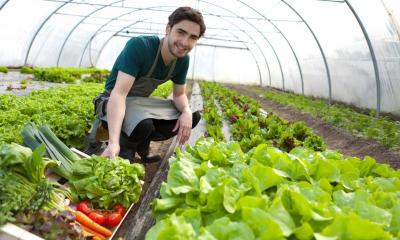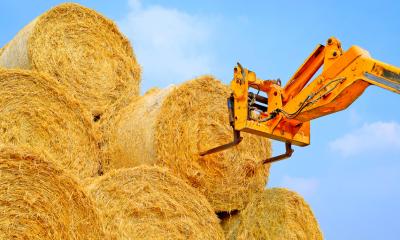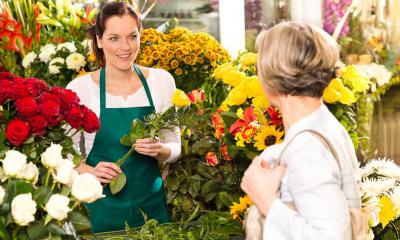
If you're aiming to earn a living from your smallholding, you'll need to be physically fit, innovative and enjoy working outdoors in all weathers. Our practical guide will help you start up and run your smallholding venture.
- Research your target market
- Establish your customer profiles
- Type of business
- Buy an existing business
Research your target market
Estimating demand
You will need to make an estimate of the type and number of customers who are likely to buy your products.
If you plan to sell produce door to door or at the 'farm gate' in some way, try to make a realistic estimate of the number of people that will buy from you in this way. You're likely to benefit from more people buying direct from you if:
- there is holiday accommodation such as a camping or caravan site nearby. Holiday makers are often keen to buy fresh produce
- your local area is not well served with shops
- you provide pick-your-own facilities. These are very popular with customers and are often treated as an enjoyable outing rather than merely a shopping trip
- farmers' markets are held in your area
You may also decide to take a stall at a farmers' market if there is one operating in your area. Before taking a stall, it's a good idea to visit the market on a few occasions to see how busy it is and to try to gauge the potential level of demand for your produce. This will also give you a chance to assess some of your direct competitors.
Trade sales
It is possible that a large proportion of your sales will be to other businesses. These may include:
- restaurants and hotels. These may be both local and national, depending on the type of produce that you sell
- food retailers. Again, these could range from your local fruit and vegetable shop or butcher to a national specialist stockist of more unusual produce
- packers and processors. If you go into any area of smallholding/farming on a large-scale basis, you are likely to be selling to these types of customer
- buyers at livestock auctions
If you plan to sell to trade customers you'll need to:
- count the number of suitable businesses/organisations in your area and further afield, if you think that your produce could reach a wider market
- work out what product ranges to offer them
- decide on the prices they'll pay - the government agriculture departments, industry bodies and other specialist sources all publish up to date price information which you may find useful when you set your own prices
- approach them to see if they would be interested - don't forget if they are already being supplied you will have to give them a good reason to change. This might be a wider range, better quality products, the appeal of locally-produced goods, lower prices or a better service
- talk to livestock auctioneers, who should be able to give you a good idea of the level of demand and the price to expect
You would be likely to sell to the types of customer listed above if your smallholding is run along broadly traditional lines (for example livestock, livestock products, fruit and vegetables). However, you may decide to branch out into other areas (as many smallholders do) and this would mean that you would have very different customers. Much will depend on the type of smallholding business you are planning to run.
Research current trends, plus legal and tax issues
Establish your customer profiles
Your market
You might have several different types of customer, depending on the nature of your business. For example:
- members of the public. You may sell to them at local farmers' markets, from your own retail outlet (generally located on your holding and possibly something as simple as an unmanned stall with an honesty box), door-to-door, mail order or online
- local retailers, such as butchers and grocers
- local catering establishments
- abattoirs
- buyers at livestock auctions, who may be local farmers or butchers, or agents for meat processing organisations
- catering establishments around the country (for example if you produce a particularly niche product)
Estimating your income
Your market research will have helped you to estimate what market there will be for your produce, whether within your local area or further afield and you should have given some thought to the price you will receive. However, accurately estimating your income can be difficult because in the farming sector prices are liable to change, sometimes significantly, due to circumstances beyond your control. Defra publishes weekly, monthly and annual price information for many agricultural commodities which you might find helpful to use when you make your estimates. You can download a range of statistical publications from the Defra section of the Gov.uk website.
You also need to consider:
- your own experience (or lack of it)
- unpredictable levels of mortality amongst your livestock
- crop damage due to bad weather or disease
- lower than anticipated yields (this applies to both crops and livestock. For example, you may anticipate that you will harvest 20 tonnes per hectare of new potatoes but only manage to lift 15 tonnes or think that you'll get 25 dozen eggs per bird per year but get only 20 dozen)
You are likely to offer your trade customers like local retailers discounted prices, for example 10% or 20% off the price you'd charge to consumers buying directly from you, as well as payment terms of up to 30 days. If you decide to sell into the wholesale supply chain, you won't get a great amount of say over the prices you'll receive and they're likely to be some way lower than the retail price.
Type of business
The range of produce that you decide to sell and any services you decide to offer will depend on:
- how much available land and outbuilding space you have
- your smallholding's soil type and climate
- whether you are targeting niche or mainstream markets
- what your personal preferences are and what you are skilled at doing
- whether you will be a traditional smallholding or explore more unusual ways of generating income
Many smallholdings include the following:
- livestock, such as cattle, sheep, pigs, goats, chickens, ducks, geese, turkeys, rabbits, horses, llamas, alpacas and so on
- fruit and vegetables. This could be on a small, garden scale up to a couple of fields
- livestock products, such as milk, wool, cheese and eggs
Smallholders often undertake other activities as well, such as renting out spare buildings, renting fields for grazing, keeping rare animal breeds, offering stabling and livery services, trout pools, mushroom production and so on.
Many smallholders branch out into areas that are completely unrelated to agriculture, such as welding, carpentry, crafts and so on in order to supplement their income.
Buy an existing business
You might decide to buy an existing smallholding rather than start your own venture from scratch. Buying a going concern can mean that the crops, livestock, customers, regular sales, staff, premises and equipment are already in place.
But buying a business can be a hazardous, expensive process unless you have the right skills and experience on your team, including legal and financial know-how. Establish the genuine trading and financial position, so that the price you pay for the business is not too high.


